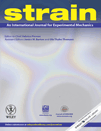
STRAIN
Scope & Guideline
Elevating Research Standards in Mechanical Engineering
Introduction
Aims and Scopes
- Digital Image Correlation (DIC) Techniques:
The journal emphasizes the use of DIC for full-field strain measurements, showcasing advancements in algorithmic approaches, hardware integration, and application across diverse materials. - Constitutive Modeling and Material Characterization:
Research often focuses on the development and validation of constitutive models for complex materials, including polymers, composites, and metals, using experimental and numerical methods. - Multiscale and Multiphysics Approaches:
A core area involves studying materials and structural behavior across scales, integrating insights from microstructural analysis to macroscopic performance, particularly in composites and advanced materials. - Impact and Fatigue Testing:
The journal frequently publishes studies on the mechanical response of materials under impact and fatigue conditions, contributing to safety and reliability assessments in engineering applications. - Innovative Measurement Techniques:
Contributions often highlight novel measurement techniques and experimental setups that push the boundaries of traditional strain measurement, including high-speed imaging and advanced materials characterization.
Trending and Emerging
- Machine Learning and Data Science Integration:
There is a rising trend in utilizing machine learning techniques for analyzing strain data and optimizing measurement processes, which enhances predictive capabilities and model accuracy. - High-Resolution and Nanoscale Measurements:
Emerging research focuses on high-resolution strain measurements at the nanoscale, particularly in sensitive materials, which is crucial for applications in nanotechnology and materials science. - Thermomechanical Behavior Studies:
Increasing attention is given to the thermomechanical properties of materials, particularly under varying temperature conditions, which is essential for applications in aerospace and automotive sectors. - Environmental and Biomechanical Applications:
Research addressing the mechanical behavior of biomaterials and environmentally sensitive materials is gaining traction, reflecting a broader interest in sustainable and health-related applications. - Advanced Composite Materials Analysis:
There is a growing focus on the mechanical properties and behavior of advanced composite materials, particularly in the context of impact and fatigue, which is vital for aerospace and automotive industries.
Declining or Waning
- Traditional Methods of Strain Measurement:
There has been a noticeable decrease in papers focusing on conventional strain measurement techniques, such as extensometry, as researchers increasingly adopt more advanced methods like DIC. - Static Testing Paradigms:
Research centered solely on static loading tests is becoming less prevalent, with a shift towards dynamic testing methodologies that better reflect real-world applications. - Basic Material Testing Techniques:
The interest in fundamental material testing techniques without integration of advanced imaging or computational methods appears to be waning, as the field moves towards more complex and integrated approaches.
Similar Journals
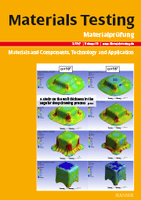
Materials Testing
Empowering Research in Mechanics of MaterialsMaterials Testing is a renowned journal published by Walter de Gruyter GmbH, serving the global scientific community in the fields of Materials Science, Mechanical Engineering, and Mechanics of Materials. With an ISSN of 0025-5300 and an E-ISSN of 2195-8572, this journal has been a significant contributor to the discourse on material performance, testing methodologies, and engineering innovations since its inception. The journal is recognized for its rigorous peer-review process and holds a commendable Q2 quartile ranking in multiple categories for 2023, showcasing its impact and relevance in the field. With open access options available, Materials Testing aims to disseminate valuable research findings and practical insights that drive advancements in technology and materials applications. By addressing the latest challenges and developments within the field, this publication serves as an essential resource for researchers, professionals, and students alike, fostering a deeper understanding of material properties and testing techniques.

Materials Physics and Mechanics
Shaping the Future with Cutting-Edge ResearchMaterials Physics and Mechanics is a pivotal journal dedicated to advancing the fields of condensed matter physics, materials science, mechanical engineering, and the mechanics of materials. Published by the Institute of Problems in Mechanical Engineering, Russian Academy of Sciences, this journal has established itself as a valuable resource since its inception, particularly from 2003 to 2004 and now continuously from 2009 to 2024. Although it currently holds a Q4 categorization in various disciplines, its contributions are critical to understanding and developing new materials and their applications in engineering. The journal provides insightful articles that explore the nuances of material properties, their behaviors under different conditions, and the physical principles governing these phenomena. Though it operates under a traditional publication model, the insights provided within its pages are invaluable to researchers, professionals, and students striving to push the boundaries of knowledge in the materials domain. Its ISSN numbers (1605-2730, E-ISSN 1605-8119) serve as a gateway to a wealth of scientific knowledge emanating from the Russian Federation, contributing to the global discourse in materials physics and mechanics.

Extreme Mechanics Letters
Exploring the Frontiers of Mechanical ScienceExtreme Mechanics Letters is a distinguished scholarly journal published by Elsevier, focusing on advanced insights in the realms of bioengineering, mechanical engineering, chemical engineering, and mechanics of materials. With an impressive Q1 ranking in multiple categories and a strong representation in Scopus, this journal serves as a vital platform for researchers aiming to disseminate pioneering findings in extreme mechanics. Since its inception in 2014, the journal has rapidly established itself as a leading publication within its field, attracting high-quality manuscripts that push the boundaries of current understanding. As an important resource for professionals and scholars alike, Extreme Mechanics Letters provides valuable insights critical for driving innovation in engineering disciplines. While the journal currently operates on a subscription-based access model, it remains committed to fostering scholarly communication across the globe, ensuring that cutting-edge research reaches its intended audience.
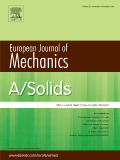
EUROPEAN JOURNAL OF MECHANICS A-SOLIDS
Your Gateway to Cutting-Edge Solid MechanicsThe EUROPEAN JOURNAL OF MECHANICS A-SOLIDS, published by ELSEVIER and based in the Netherlands, stands as a premier outlet for research in the field of solid mechanics. With an impressive track record since its inception, the journal has been indexed in prestigious categories including Materials Science, Mechanical Engineering, and Mathematical Physics, achieving Q1 quartile status across these domains in 2023. This recognition underscores the journal's impact, with Scopus rankings placing it in the top echelon of its respective fields, such as #39 in General Physics and Astronomy and #116 in Mechanical Engineering, demonstrating its significance and wide-reaching influence in the academic community. Scientists, engineers, and researchers are encouraged to submit their cutting-edge findings in areas related to solid mechanics, contributing to the journal's mission of advancing knowledge and innovation in this vital discipline. The journal's comprehensive scope allows for interdisciplinary engagement, making it an essential resource for professionals and students alike seeking to explore the latest developments in mechanics of materials and related areas.

FATIGUE & FRACTURE OF ENGINEERING MATERIALS & STRUCTURES
Unraveling the Complexities of Material BehaviorFATIGUE & FRACTURE OF ENGINEERING MATERIALS & STRUCTURES, published by WILEY, is a leading journal in the domains of materials science and mechanical engineering, with a solid reputation for advancing research on the behavior of materials under fatigue and fracture conditions. With an impressive impact factor and ranking in the top quartiles of its categories in 2023, this journal serves as a vital resource for academics, professionals, and students interested in the intricate mechanics of materials. The journal encompasses a comprehensive scope, covering both experimental and theoretical methodologies designed to understand and predict material performance under various loading conditions. As the journal continues to thrive since its inception in 1979 and is set to converge until 2024, it remains an essential platform for disseminating innovative and crucial findings in this specialized field. Researchers are invited to explore the wealth of knowledge presented within its pages, paving the way for enhanced engineering practices and material design.
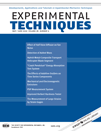
EXPERIMENTAL TECHNIQUES
Exploring the Frontiers of Mechanics and MaterialsEXPERIMENTAL TECHNIQUES, an esteemed journal published by Springer, serves as a crucial platform for fostering innovation and research in the fields of Mechanical Engineering and Mechanics of Materials. Established in 1975 and continuing its legacy through to 2024, it aggregates a wealth of studies that exemplify rigorous experimental methodologies and emerging technologies. With its remarkable standing as a Q2 journal in Mechanical Engineering and Q3 in Mechanics of Materials, it ranks in the top half of its categories on Scopus, indicating its relevance and impact in the academic community. While the journal is not open access, it ensures accessibility to high-quality research findings essential for advancing knowledge and expertise among researchers, professionals, and students alike. EXPERIMENTAL TECHNIQUES continues to be a vital resource for those involved in the dynamic landscape of experimental mechanics, aiming to push boundaries and explore new frontiers in engineering.
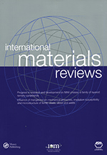
INTERNATIONAL MATERIALS REVIEWS
Advancing Knowledge in Materials Chemistry and EngineeringINTERNATIONAL MATERIALS REVIEWS, published by SAGE Publications Inc, is a leading journal dedicated to the comprehensive analysis of contemporary research in the fields of materials chemistry, mechanical engineering, mechanics of materials, and the study of metals and alloys. With an impressive impact factor and a Q1 ranking across multiple categories such as Materials Chemistry and Mechanical Engineering in 2023, it ranks amongst the top journals for innovative materials research. The journal has a long-standing history since its inception in 1987 and continues to serve as a crucial resource for academics and professionals alike. Although it is not open access, it is renowned for its rigorous peer-review process and its commitment to disseminating high-quality materials science research globally. Researchers, students, and industry professionals benefit greatly from the journal's insightful reviews, both for the advancement of theoretical knowledge and practical applications within the fast-evolving materials field.
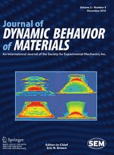
Journal of Dynamic Behavior of Materials
Pioneering Insights into Dynamic Material PropertiesThe Journal of Dynamic Behavior of Materials, published by SpringerNature, serves as a premier platform for the dissemination of innovative research in the fields of materials science and mechanics of materials. With its ISSN 2199-7446 and E-ISSN 2199-7454, this international journal has established itself since its inception in 2015, showcasing groundbreaking insights into the dynamic properties and behaviors of various materials. Operating from Switzerland and headquartered in London, this journal embraces an open-access philosophy, albeit not entirely, to enhance research visibility. According to the Scopus rankings, it is positioned in the Q3 quartile for both materials science and mechanics of materials, indicating its growing prominence in the academic landscape. Researchers and professionals alike benefit from its wide-ranging contributions that address contemporary challenges and advancements, making it a critical resource for advancing knowledge and innovation in these crucial fields.
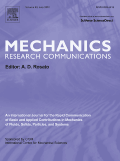
MECHANICS RESEARCH COMMUNICATIONS
Transforming Ideas into Engineering BreakthroughsMECHANICS RESEARCH COMMUNICATIONS, published by PERGAMON-ELSEVIER SCIENCE LTD, is a prestigious journal in the fields of Civil and Structural Engineering, Condensed Matter Physics, Materials Science, and Mechanical Engineering. With an ISSN of 0093-6413 and E-ISSN of 1873-3972, it has made significant contributions to the understanding and advancement of mechanics and materials since its inception in 1974. The journal is well-regarded in academia, holding a Q2 ranking across multiple categories as of 2023, and ranking in the 65th percentile for Mechanical Engineering. Researchers and professionals benefit from its peer-reviewed content, which includes a wide range of articles from fundamental research to applied technological developments. Although currently not an open access journal, it remains a vital resource for those focused on innovating within the engineering and materials science domains. With its established legacy, MECHANICS RESEARCH COMMUNICATIONS continues to shape the discourse in mechanics and engineering, making it essential reading for students and practitioners alike.
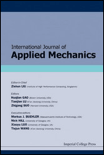
International Journal of Applied Mechanics
Empowering Innovation in Mechanical EngineeringThe International Journal of Applied Mechanics, published by World Scientific Publishing Co Pte Ltd, is a premier platform that serves the fields of materials science, mechanical engineering, and mechanics of materials. Located in Singapore, this journal has established itself as a crucial resource for researchers, professionals, and students, with its convergence of scholarly work from 2009 to 2024. Ranked in the Q2 category across notable disciplines, including Materials Science, Mechanical Engineering, and Mechanics of Materials, it reflects a strong commitment to publishing high-quality research that pushes the boundaries of knowledge in applied mechanics. Despite being a non-open access journal, its successful Scopus rankings, including an impressive rank of #151 in Mechanical Engineering, signify its substantial impact and recognition within the academic community. This journal not only aims to disseminate pioneering research but also to foster collaboration and innovation in the rapidly evolving landscape of applied mechanics.